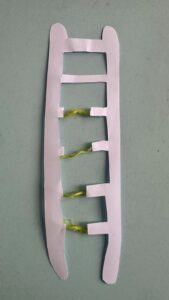forms of escape
Summary
The OER I have created is based on the learning theory of the double-loop and the conceptual framework of contemporary art to question the intersubjective, prototypical category of escape. The instruction will guide the learner through a hands-on experimentation with material, form, deconstruction, and reconstruction, that echoes the double-loop of learning. At each stage, the learner is given a simple direction, backed up by a dataset of ideas, materials, actions, or questions.

double-loop © 2025 by Kirsty Smith is licensed under CC.
Engage in double-loop thinking to develop a form of escape by following these steps:
Collect material
(1-2 mins)
paper, clay, pens, pencils, wood, plasticine, stone, fabric, cardboard
Think of a form of escape, imagine any design
(4 mins)
daydream, music, spiral, book, text, boat, arch, tower, rope, sphere, open door
Out of the material(s), form your thought into reality
(4 mins)
create, construct, form, cast, fold, rip, stick, wrap, scale, draw, cut
Distance it from the thought
(1-2 mins)
abstract, rip, scrape, swap, exchange, unfold, damage, graffiti, erode, scribble
Reconstruct
(1-2 mins)
fix, recreate, reform, refold, stick, tape, revise
Reflect
(3 mins)
Explain your original idea of escape to yourself or someone else.
How could it be used as a form of escape?
What happened when you followed the deconstructive step?
What further changes would you make?
Have you created a form of escape?

escape ladder © 2025 by Kirsty Smith is licensed under CC BY 4.0.
Congratulations, you have engaged in double-loop thinking! For further reading, please visit the list below:
Argyris, Chris. “Double-Loop Learning, Teaching, and Research.” Academy of Management Learning & Education 1, no. 2 (2002): 206–18. https://doi.org/10.5465/amle.2002.8509400
Clark, Kevin. “Double-Loop Learning and Productive Reasoning: Chris Argyris’s Contributions to a Framework for Lifelong Learning and Inquiry.” Midwest Social Sciences Journal 24, no. 1 (2021): 33–52. https://doi.org/10.22543/0796.241.1042.
Farley, Paul. “In the Loop – 3. A Strange Loop – BBC Sounds.” 2023. BBC. 2023. https://www.bbc.co.uk/sounds/play/m001nvp8.
Schneiderheinze, Dirk . 2021. “Bach’s Crab Cannon as It Could (Actually) Sound on a Clear Möbius Strip.” YouTube. December 30, 2021. https://www.youtube.com/watch?v=oYOEKS3Xhrs.


